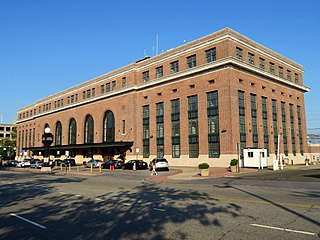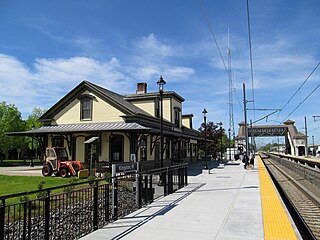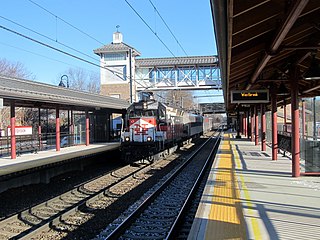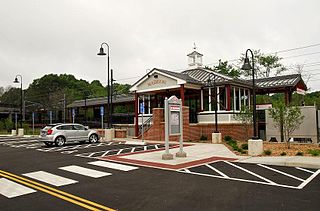
The Northeast Corridor (NEC) is an electrified railroad line in the Northeast megalopolis of the United States. Owned primarily by Amtrak, it runs from Boston in the north to Washington, D.C., in the south, with major stops in Providence, New Haven, Stamford, New York City, Newark, Trenton, Philadelphia, Wilmington, and Baltimore. The NEC is roughly paralleled by Interstate 95 for most of its length. Carrying more than 2,200 trains a day, it is the busiest passenger rail line in the United States by ridership and service frequency.

New Haven Union Station is the main railroad passenger station in New Haven, Connecticut. It is the third such station in the city of New Haven, preceded by both an 1848 built station in a different location, and an 1879 built station near the current station's location. Designed by noted American architect Cass Gilbert, the present beaux-arts Union Station was completed and opened in 1920 after the previous Union Station was destroyed by fire. It served the New York, New Haven and Hartford Railroad for the next five decades, but fell into decline following World War II along with the United States railroad industry as a whole.

Shore Line East (SLE) is a commuter rail service which operates along the Northeast Corridor through southern Connecticut, United States. The rail service is a fully owned subsidiary of the Connecticut Department of Transportation (CTDOT) and is operated under the CT Rail brand. SLE provides service seven days a week along the Northeast Corridor between New London and New Haven; limited through service west of New Haven to Bridgeport and Stamford operates during weekday rush hours. Cross-platform transfers to Metro-North Railroad New Haven Line trains are available at New Haven for service to southwestern Connecticut and New York City. Pre-COVID, around 2,200 riders used the service on weekdays.

Providence station is a railroad station in Providence, Rhode Island, served by Amtrak and MBTA Commuter Rail. The station has four tracks and two island platforms for passenger service, with a fifth track passing through for Providence and Worcester Railroad freight trains. It is now the 11th busiest Amtrak station in the country, and the second-busiest on the MBTA Commuter Rail system outside of Boston.

Springfield Union Station is a train and bus station in the Metro Center area of Springfield, Massachusetts. Constructed in 1926, Springfield Union Station is the fifth-busiest Amtrak station in the Commonwealth, and the busiest outside of Greater Boston.

The New York, Providence and Boston Railroad, normally called the Stonington Line, was a major part of the New York, New Haven and Hartford Railroad between New London, Connecticut and Providence, Rhode Island. It is now part of Amtrak's high-speed Northeast Corridor.

Hartford Union Station is a railroad station in Hartford, Connecticut, United States on the New Haven–Springfield Line. It is served by Amtrak Amtrak Hartford Line, Northeast Regional, Valley Flyer, and Vermonter intercity rail service, plus CT Rail Hartford Line commuter rail service and CTfastrak bus rapid transit service.

Kingston is a historic railroad station located on the Northeast Corridor in the village of West Kingston, in the town of South Kingstown, Rhode Island. It was built at this location in 1875 by the New York, Providence and Boston Railroad, replacing earlier stations dating back to the opening of the line in 1837. Current rail services consist of Northeast Regional trains in each direction, most of which stop at the station. Historically Kingston provided commuter rail service to Providence and Boston via Amtrak's commuter rail services. The MBTA is looking at extending their commuter service on the Providence/Stoughton Line.

Old Saybrook station is a regional rail station in Old Saybrook, Connecticut. It is served by both Amtrak Northeast Regional intercity trains and CT Rail Shore Line East commuter service.

New London Union Station is a railroad station on the Northeast Corridor located in downtown New London, Connecticut, United States. Union Station is a station stop for most Amtrak Northeast Regional trains and all CT Rail Shore Line East commuter rail trains, making it the primary railroad station in southeastern Connecticut. It serves as the centerpiece of the Regional Intermodal Transit Center, with connections to local and intercity buses as well as ferries to Long Island and Fishers Island, New York, and Block Island, Rhode Island. The station has one side platform and one island platform serving the two-track Northeast Corridor; the latter platform also serves a siding track that connects to the New England Central Railroad mainline.

Westerly station is a passenger rail station on the Northeast Corridor located just north of downtown Westerly, Rhode Island. It is served by Amtrak's Northeast Regional. Amtrak's Acela also passes by this station, but does not stop.

The Hartford Line is a commuter rail service between New Haven, Connecticut, and Springfield, Massachusetts, using the Amtrak-owned New Haven–Springfield Line. The project is a joint venture between the states of Connecticut and Massachusetts, with support from the federal government as well. CT Rail-branded trains provide service along the corridor, and riders can use Hartford Line tickets to travel on board most Amtrak trains along the corridor at the same prices. The service launched on June 16, 2018.

Berlin station is a train station located in the Kensington neighborhood of Berlin, Connecticut. It is on the New Haven–Springfield Line and is served by Amtrak's Northeast Regional, Hartford Line, and Valley Flyer, in addition to the Hartford Line commuter rail. Two high-level platforms, each six cars long connected by an overhead pedestrian bridge opened at the Hartford Line service launch on June 16, 2018. On December 21, 2016, the historic 1900-built station building was destroyed by a fire.

Windsor station is a historic railroad station on Amtrak's New Haven–Springfield Line, located in downtown Windsor, Connecticut. It is served by Amtrak Northeast Regional and Valley Flyer intercity service and CT Rail's Hartford Line commuter rail service. The nearby Hartford & New Haven Railroad-Freight Depot serves as the home of the Windsor Arts Center.

Windsor Locks station is an Amtrak and CT Rail train station in Windsor Locks, Connecticut, on the New Haven–Springfield Line. It is served by four Amtrak services - the Amtrak Hartford Line shuttles, Northeast Regional, Valley Flyer, and Vermonter - as well as CT Rail Hartford Line commuter rail trains.

Westbrook station is a regional rail station on the Northeast Corridor, located off Connecticut Route 153 just north of the village center of Westbrook, Connecticut. It is served by the CT Rail's Shore Line East commuter rail service; Amtrak's Acela and Northeast Regional services run through the station without stopping. Westbrook has two high-level side platforms, each two cars long.

Madison station is a railroad station on the Northeast Corridor located in Madison, Connecticut, United States. It is served by the CT Rail Shore Line East commuter rail service. The station has a single side platform serving the southern track of the two-track Northeast Corridor.

The Mystic River Railroad Bridge is a railroad bridge carrying Amtrak's Northeast Corridor over the Mystic River in Mystic, Connecticut, between the towns of Groton and Stonington.

Niantic was a train station on the Northeast Corridor located in the Niantic village of East Lyme, Connecticut. Opened in the 1850s, it was rebuilt in 1899 and again in 1954 by the New Haven Railroad. It closed in 1972, then reopened from 1978 to 1981 for use by the Amtrak Beacon Hill. A new station has since been proposed to be built in Niantic to serve the Shore Line East commuter rail service.

CT Rail, stylized as CTrail, is the brand for commuter rail services overseen by the Connecticut Department of Transportation (CTDOT), in the U.S. state of Connecticut, with services on the Hartford Line extending into Massachusetts. CTDOT oversees two lines: Shore Line East, between New Haven and New London, Connecticut, and the Hartford Line, from New Haven, through Hartford, to Springfield, Massachusetts.























